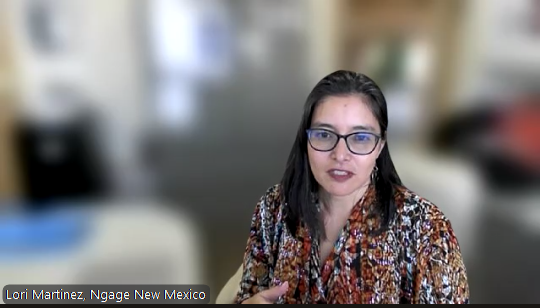Rising costs and child care strain are squeezing Latino families in southern New Mexico
Community leaders say rising costs, child care access and immigration fear are reshaping daily life for Latino families across southern New Mexico.

The 2025 National Latino Family Report connects statewide data to the lived realities of families in Doña Ana County.
Damien Willis, Organ Mountain News
LAS CRUCES - Across southern New Mexico, families with young children describe the same quiet strain — stretching paychecks between groceries and rent, piecing together child care that may not fit work schedules, navigating rising health care costs and moving through everyday routines under the steady weight of immigration fear.
Those realities were echoed during a national webinar hosted by Abriendo Puertas/Opening Doors and UnidosUS, where panelists discussed the 2025 National Latino Family Report and how its findings reflect what families in Doña Ana County and throughout the state continue to face.
Local voices connect national data to southern New Mexico
Teresa Madrid, executive director of the Albuquerque-based Partnership for Community Action, said the report reflects daily conversations her organization has with families seeking stability and opportunity.
Families are working harder than ever, she said, while juggling rising food prices, unstable housing and fear around immigration enforcement. Despite those challenges, Madrid described a pattern of determination and long-term planning, with parents actively pushing for better conditions for their children.
“The report shows families are not passive,” Madrid said during the meeting. “They are saving, planning, showing up at policy tables and speaking clearly about what they need to thrive.”
Lori Martinez, executive director of Ngage New Mexico, said southern New Mexico’s realities are often flattened or misunderstood in broader state conversations. Doña Ana County, she noted, operates under unique conditions shaped by its proximity to the border, its distinct media market and its long-standing cultural identity.
Because the county sits within 100 miles of the international border, residents face different legal exposure during immigration encounters. That reality adds a layer of anxiety to basic routines such as dropping off children at school, attending child care or visiting health clinics.
“People are not just thinking about prices or schedules,” Martinez said. “They are thinking about safety. They are thinking about whether an ordinary task could suddenly turn into a frightening encounter.”
She noted that while the state’s political power centers sit in Albuquerque and Santa Fe, families in southern New Mexico often rely on El Paso-based media for news and information — creating a disconnect between where decisions are made and how those decisions are experienced and understood on the ground.

Economic pressure reshapes family life
The report found that 48 percent of New Mexico families identified the rising cost of living as their top concern. Forty-one percent said improved wages are essential, while 35 percent cited affordable housing shortages as a destabilizing factor.
Madrid said those figures align closely with what families share during community engagement sessions. Parents speak openly about trade-offs, including whether to pay rent, fill prescriptions or reduce participation in children’s activities.
She pointed to state investments, including $110 million for affordable and transitional housing and expanded SNAP protections, as meaningful steps. Still, she said many families need flexible and immediate support to remain stable.
Madrid highlighted guaranteed income initiatives and baby bonds as potential tools for strengthening household stability and building long-term generational wealth. Those programs could help families manage unexpected expenses such as car repairs, medical costs or temporary income disruptions.
Martinez added that child care remains one of the most destabilizing costs in the region. Infant care often exceeds monthly rent, forcing families to lean on relatives, informal care networks or unlicensed home arrangements.
For families working multiple jobs or irregular shifts, she said, formal child care systems often fail to match real-world schedules, leaving parents with limited options.
Universal child care brings promise and pressure
Panelists described New Mexico’s move toward universal child care as historic and long overdue. Madrid traced the trajectory back more than a decade to grassroots organizing efforts and the eventual passage of Constitutional Amendment 1, which expanded funding for early childhood education.
Universal child care, Madrid said, could save families thousands of dollars each year and provide greater stability for working parents. However, she cautioned that long-term success depends on ensuring enough providers exist across urban, rural and frontier communities.
Martinez noted that Doña Ana County relies heavily on home-based providers and that many Latino families prefer trusted caregivers who share their culture and language. Supporting those providers through fair reimbursement, training and credential pathways will be critical to sustainability.
Recent data shows the county’s child care workforce nearly doubled between 2023 and 2024, a trend Martinez credited to state investment, higher reimbursement rates and expanded support services for caregivers.
Even with that growth, she said supply continues to struggle to meet demand, particularly in remote areas where care deserts persist.

Bilingualism seen as strength, not luxury
One of the strongest findings in the report shows 93 percent of participating New Mexico families want their children to be bilingual. That figure surpassed national averages and reflects the cultural priorities of many households.
Martinez said families understand bilingualism as both a cultural anchor and an economic asset. Children who grow up bilingual show cognitive benefits, stronger identity development and improved long-term opportunity.
However, she noted that structural barriers prevent many Spanish-speaking educators from advancing beyond associate degrees. Without bilingual higher education pathways, those educators encounter professional ceilings that limit wages and system capacity.
“We rely on these educators,” Martinez said. “They are the backbone of early childhood care in our communities. But then we block their upward mobility.”
Madrid added that expanded home-based child care allows more children to remain in environments that reflect their language and lived experience. She said this preserves cultural continuity while strengthening educational outcomes.

Immigration fear shapes daily decisions
Martinez described growing reliance on neighborhood alert systems, mutual aid networks and Know Your Rights trainings as families seek protection from traumatic enforcement encounters. Families exchange information when Immigration and Customs Enforcement activity is observed, giving one another real-time warnings.
Community organizations distribute red cards outlining legal rights and provide guidance about administrative versus judicial warrants. Martinez said these tools empower families to respond safely and lawfully while protecting their dignity.
“These fears are not theoretical,” she said. “They affect whether people go to school, whether they seek help, whether they trust systems.”

Health care access remains uneven
Families cited health care affordability and availability as another major concern. Long travel distances, limited provider availability and rising insurance costs continue to disrupt care.
Madrid noted that New Mexico relies on Medicaid at nearly twice the national rate. She said the state’s approval of health insurance subsidies will help offset premium increases for families using the exchange.
Martinez highlighted provider shortages, particularly in frontier counties where residents may drive hours for routine services. She also expressed concern about private equity ownership of hospitals and clinics and the effect that model may have on long-term quality of care.
“When profit becomes the primary driver,” she said, “care quality becomes secondary.”
What Latino families want local media to understand
When asked what local journalists should take away from the report, Madrid emphasized that Latino families possess agency, knowledge and vision. She urged journalists to move beyond surface statistics and explore lived experiences and structural realities.
“Listening is not optional,” she said. “Families are saying clearly what must change.”
Martinez highlighted the role of community journalism in amplifying voices often excluded from mainstream policy narratives, especially in southern New Mexico, where residents already feel disconnected from state-level dialogue.
She said trusted local outlets serve as critical bridges between families, policymakers and systems of power.
Hope grounded in community
Despite the challenges, both panelists said their optimism stems from the strength of New Mexico families and enduring community networks.
Martinez spoke about the deep sense of connection and mutual care that defines the region. Madrid described families consistently stepping into leadership roles, advocating for change and investing in their children’s futures.
“They already carry the solutions,” Madrid said. “Our responsibility is to keep listening and keep building alongside them.”
Damien Willis is founder and editor of Organ Mountain News. If you have a personal story to share or a lead we should follow up on, reach out at OrganMountainNews@gmail.com or connect with him on X at @damienwillis.
Las Cruces teen charged with receiving firearm while under indictment — Latest local juvenile firearms case
Federal shutdown period saw spike in immigration and border-related prosecutions in New Mexico — New data shows charges rose sharply during the federal hiatus
Las Cruces police arrest 16-year-old in deadly Bugatti Drive shooting — Public video helps identify teen suspect



